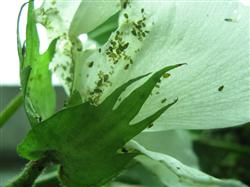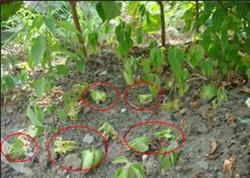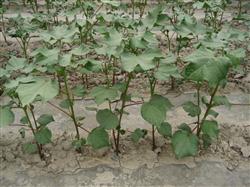How to control the blind Toona sinensis by planting cotton?

How to control the blind Toona sinensis by planting cotton? Please introduce the method that cotton blind stink bug can cause harm in cotton seedling stage and bud and boll stage. Now it is the bud blooming and boll setting period of cotton reproductive growth, and it is also the main harmful period of blind stink bug, which can cause cotton buds and bolls to fall off. However, the current transgenic insect-resistant cotton is not resistant to piercing and sucking mouthparts pests such as Toona sinensis. Once the climatic conditions are conducive to the occurrence of Toona sinensis, it is easy to cause serious loss of cotton yield. Therefore, the prevention and control must be strengthened on the basis of understanding the occurrence and harm law of the blind Toona sinensis. Cotton blind stink bugs include green bugs, medium-black bugs and other species, which are often mixed and are oblong small and medium-sized insects with three states of egg, nymph and adult. The egg is eggplant-shaped. On cotton, the egg is laid on the main vein of the leaf, the edge of the big leaf, the petiole and the subcutaneous layer of the green boll. It is harmful to adults and nymphs and is highly active. The damage to the top and edge of cotton results in perforation of cotton leaves, "leaf-breaking madness", headless seedlings and multi-headed seedlings. After the bud was killed, macula appeared on the bud crown, and the anther shrunk, affecting fertilization and causing shedding. After the young boll was injured, there were water-stained brown round thorn spots on the bell shell, then turned black-brown, and the internal ovule was damaged, which affected the fiber development and formation. In serious cases, it could be sunken into a stiff fruit or even fall off. Cotton blind stink bug is a multi-host and omnivorous pest, which not only harms cotton, but also harms broad bean, alfalfa, vetch, soybean, potato, carrot, sunflower, mint, peanut, Chinese wolfberry, aggregate grass, abutilon, wild radish, red clover, sugar beet, celery, chrysanthemum and other crops, as well as poplar, willow, mulberry, locust and other trees and many kinds of weeds. The control of the source of the weevil outside the cotton field is very important to reduce the occurrence and harm of the weevil in the cotton field. Blind Toona sinensis is often difficult to detect in the initial stage of cotton field damage, and the control is too late when the symptoms of cotton plant damage are obvious. therefore, on the basis of pest monitoring, chemical control in insect source field and cotton field should be strengthened and used scientifically according to the guidance of local agro-technical departments. There are 4 insects in 100 plants of Toona sinensis in seedling stage, 12 in bud stage and 20 in boll stage, which can be controlled by Shixu, Xinbao, Regent and phoxim, and pay attention to the control of pests in other cotton fields. For example, 90 ml per mu of 12% idle EC or 24% Xinbao EC can be sprayed evenly to control blind Toona sinensis, corn borer and cotton bollworm. Organophosphorus pesticides such as omethoate, phoxim, 2.5% fenvalerate and Regent are also effective in the control of Toona sinensis. The effect of spraying with motorized sprayer is good, and when using a small manual sprayer, several machines can be used at the same time, and the spraying effect is better surrounded by cotton fields. The host crops interplanted with Toona sinensis in cotton field should be sprayed together with emphasis on tender head, edge center and bud boll. Pay attention to the safe use of drugs during the high temperature season, and the use of highly toxic and highly toxic pesticides is prohibited. For the many-headed seedlings caused by blind Toona sinensis harming cotton plants, we can give full play to the role of cotton plant regulation and compensation through timely pruning treatment, such as leaving two heads or a strong branch, especially in a large amount of compensation in buds, which can increase the number of bolls and recover part of the loss. reduce the damage loss of blind stink weevil to a minimum. Click to get more cotton planting technology click to get more food crop planting technology
- Prev

How to prevent cotton bolls from falling off at high temperature?
How to prevent cotton bolls from falling off at high temperature? Please introduce control methods cotton high temperature boll drop can refer to the following methods for control: first, heavy application of flower boll fertilizer. Flower and boll fertilizer is usually applied in 2-3 times. The first and second treatments were applied at flowering and about 10 days after flowering. Acre dressing available nitrogen fertilizer 10 - 15 kg, potassium...
- Next

How should cotton be managed in the middle and later stages of planting?
How should cotton be managed in the middle and later stages of planting? Please give guidance on cotton management methods in the middle and later period, you can refer to the following methods: first, pruning management. For the luxuriant branches and leaves that have covered the whole cotton field, the old leaves, yellow leaves and empty branches without buds in the lower part of the main stem can be removed to achieve the effect of light transmission.
Related
- The first cup of black tea in spring, the flavor and history of tea gardens in Kenya, Africa
- The computer can not only choose potatoes, but also grow tea rice. AI will grow winter oolong tea champion.
- It is not only the inflated tea bitten by insects, but also engraved with the four seasons tea in Beipu.
- The Oriental Beauty Tea Festival in Zhuxian County takes the stage at the weekend to experience the plus-size feast of oil tea.
- & quot; Oriental Beauty Tea & Exploration of Emei in Hsinchu, the hometown of quot;
- The new variety of strawberry "Tainong 1" dessert is the first choice with mellow aroma. Crimson gorgeous
- History of Tea in Taiwan: from Wild Inner Mountain to Export Tea Garden
- Two types of Taiwan Oriental Beauty Black Tea won the British three-Star Award for Childhood Tea Xiang Zhang Jiaqi changed from pilot to champion tea maker.
- Banana species and varieties: the planting history of Taiwan Xianren banana and dwarf banana is long, is banana disease resistant?
- Coffee planting Technology: Qianjie Coffee from Seedling to harvesting

